| Home Medical Index | First Posted: Aug. 19, 2010 Jan 21, 2020 | |
Horse Head Woundsby Debora Johnson 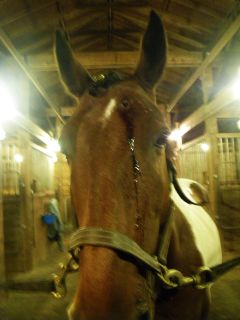 The above images were taken, August 15, 2010 - Sunday @ 8:30 PM, the night this happened. I asked Kate to please take the pictures.  Bucket hook - The culprit was coated with blood! My horse "scalped" himself in his stall on the feed bucket hook. They are blunt, not pointed, and are regular issue in tack shops. These pictures were taken right after this happened. 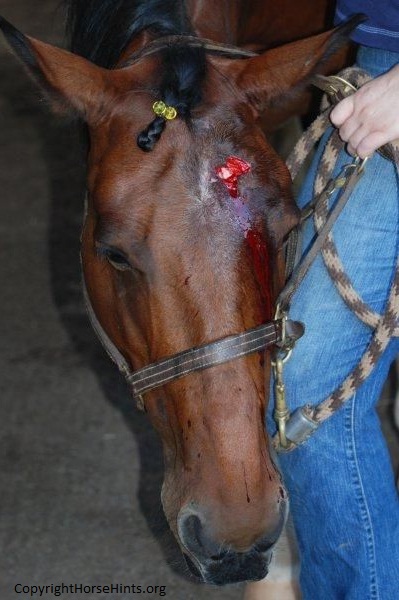 The vet, Dr. Carol Sabo, Haymarket Equine Veterinary, 5513 Catharpin Road, Gainesville, VA 20155-1363, (703) 754-3309 and her Tech, Sara (Also at the nail in foot scare) arrive and go to work on the wound. I have always maintained that even if you put a horse in a "padded cell" it will find a way to hurt itself. Recently my horse was put in his stall while the caregiver worked with her horse on a longe line. He was in his stall with food, water, lots of clean bedding and my husband's horse, his buddy, was in the stall right beside him. Neither horse had on halters. This scenario has been going on for 2 years. This has been his stall for 5 years. It is not as though anything was new or different. Every precaution is taken by their caregiver. After the training session had finished, their "on premiss mom" came to let them back out and noticed that my horse had blood running down him face. She took a careful look and was mortified at what she found. She called me immediately and together we assessed the situation, by phone, as best we could. Of course, this is on a Sunday night, around 8:30 PM. Below you will see some of the mental gymnastics that we went through and how we proceeded. Just keep in mind that head and neck wounds are very common.
With all that in mind, this is what we did, but next time I will call the vet immediately no matter what day or time it might be! We made all of these determinations the best that we could. The wound was cleaned with saline solution, a furicin spray was put on the wound to temporarily cut down on infection, we gave my horse SMZ antibiotics (one dose), 1 gram of bute paste was given, he was put in the stall without these bucket hooks, he was observed for an hour or so. The next morning his temperature was taken, he was checked all over (to see if there were any newly developed problem) by his "on property mom." She made a note of everything on an information board that is kept in the tack room. That way I would know that early AM check and be able to give all this information to the vet. My husband and I headed out to the barn before the vet office opens. On the way we called on the cell phone to find out how to proceed. It takes about 50 minutes to get to the barn depending on traffic. The vet got to the barn before we did (the practice is 10 minutes from where A Patchy is stabled), gave a tranquilizer and then we showed up. She explained what she saw. She said what we did was fine but that more needed to be done. She also indicated that the time lapse would not make a difference in his case. We said do what you need to do. This is what Dr. Sabo said and what she did. She and the vet tech, Sarah, who also helped when A Patchy got a nail in his foot, were wonderful! Patient History Note: Augsut 16, 2010/Monday Morning @ 10:00 AM
This was written on my copy of the evaluation: "Trauma to the forehead, left of center, "y" shaped cut with dead flap and 2 cm x 2 cm bone exposure, no fractures noted, clipped, prepped, debrided, removed hair and clot debris flushed {used an antibiotic flush}, sutured, made sliding "h" flap to fill defect, still small area to granulate in, sprayed with furacin already on"abs" (abbreviation often used by vets for antibiotics), current on tetanus shot; given in spring." Note: "Furacin Spray - This spray can be used to topically cover wounds. It has an antibiotic in the spray and can help prevent infections in wounds that can not be wrapped. Likewise, you can spray it on injuries that are going to be wrapped to help protect it. If the wound is deep enough that it may require stitches, do not put anything in it besides KY Jelly® or water until we evaluate it. Take care whenever spraying aerosols around horses, some horses do not like the sound of the spray and can get nervous. Talking loudly or whistling while you spray sometimes does the trick." Danah Nuest, DVM/Greener Pastures Veterinary Clinic, Inc. Plan
I asked permission to take these pictures through this procedure so that it could be shared on HorseHints. It is my hope that this will be an informational piece that will be helpful if you find yourself in this situation. Throughout this entire episode we all tried to keep a smile and be positive. Our vet told us that she had taken a course that was called something like "Reconstructive Surgery!" I may not have that exactly right but you get the picture. Then she smiled at my husband and me and said that it turned out to be how to suture up an old wound on a horse. We all laughed! 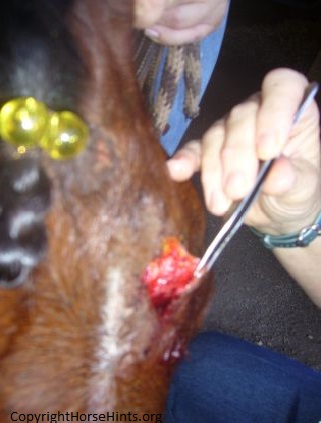 Flap held out/Cut deep, down to bone!
  Suturing  After suturing 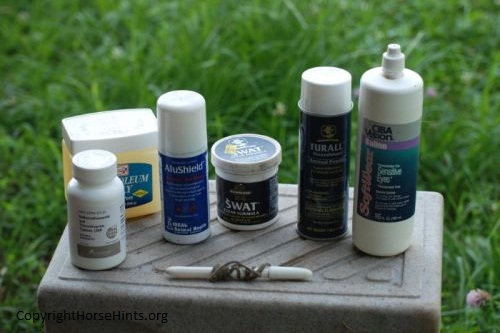 After Vet left: The post op care products we used.  We will continue this process for 14 days. That is when the sutures will be removed. On Friday around 11:00 AM we arrived at the barn and visually checked, once again, on A Patchy. Kate and I are in contact every day by phone. He is coming along well. There is a small opening at the top of the wound. It looks almost like a tiny paper cut that you would get in your finger. The skin is slightly open-about the size of the half moon on your pinky finger. The oozing has stopped. There is no sign of an elevated temperature (100.4 degrees). There is no increase in swelling. The wound smells fine. We are horse people and we smell the wound! Not yuck to us, but an important way to detect unseen infection brewing! There is still a tiny depression in one area, however, that is certainly to be expected. We suspect if all continues to go well that "half moon" area will fill in with tissue and be fine. If not, then it will be a new piece of jewelry! His forelock will cover this area anyway. There is no sign of any nerve damage. On this fifth day the wound is on its way to healing, but is not yet healed. If the stitches were torn open, as the wound now itches and A Patchy is trying to accommodate that itch through a fly mask, the wound is in danger of being torn open. Obviously, that would be a bad thing! By the tenth day the wound is mostly healed. Hopefully we will make it to 14 days uneventfully and all will end fine. Stay tuned. Day 8/Monday - August 23, 2010 - AM - Last dose of SMZ. From now on no more oral antibiotics. A Patchy will only have topicals, however, no more than every other day as they can retard the healing process. The images, below, will show the progression on the healing process.  This image was taken August 23 @ 10:00 AM Day 9/Tuesday - August 24, 2010 - 10:30 AM - The images, below, were taken to show the healing process. It is looking really good. Gave Haymarket a call to give them a status update. He is still wearing his fly mask. We have been lucky that the weather has been cool and today there are skattered showers. Tomorrow, Wednesday, our daughter will by flying in to visit us. The vet said we have a green flag and can ride. That means A Patchy will be going for a 3 hour ride at the Manassas Battlefield. He will be really happy to get out! I have removed the brow band from his bitless bridle so that there will be no rubbing on or near his wound. He will also be wearing a fly mask while we are out to protect his wound from insects, dirt, etc. When we get back to the barn he will have a complete cleaning of the area, I will wipe with an antiseptic and spray on AluShield and apply swat. 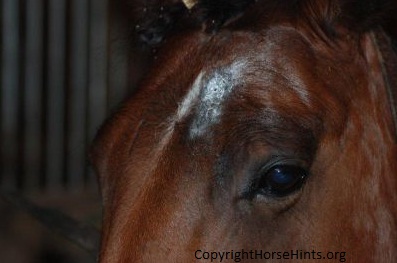 Day 9/Tuesday, August 24, 2010 - The wound is healing nicely. No signs of infection. Stitches are holding well. Also, notice that the round area, just above the major wound, and the crescent shaped area to the left of A Patchy's forehead, have already begun to fill in with hair. Those areas were just scraped, not bleeding or open. Day 10/Wednesday - August 25, 2010 - My daughter and I rode today. Everything went well. The ongoing post op care was done. The day was cool and beautiful. Both horses were so happy to be out. Day 11/Thursday, August 26, 2010 - My husband and I rode today. The horses were great. A Patchy is healing well. He seems to not be too sensitive in the area, now. There are some depressions that you cannot see in these pictures; however, we can feel them. They are there because the underlying tissue was completely gone. The bone was exposed. It will take time for the tissue to fill in. I am not concerned about that. There is one small area that looks like a small black line where there are no stitches. It was pink, but now is beginning to grow together. It should be fine. There are no signs of infection. We are on schedule. Both my husband's horse, Rusty, and my horse, A Patchy, were so happy to be out on the trail today. I know it will life their spirits. 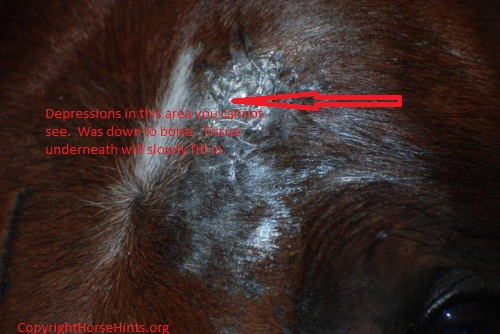  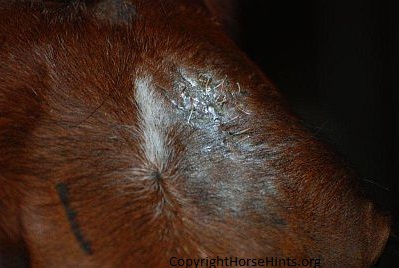  Day 13/Saturday, August 28, 2010 - My husband, Bill, and I rode again today. Both horses were extatic to be out. The day was lovely, cool and no bugs. There was a slight breeze. We saw lots of wildlife--four footed, two footed, winged and aquatic. There are some subtle changes that you cannot really see from the pictures. However, it would appear that some of the underlying structures are beginning to fill in. There is still a depression but under some of the hide where only bone was left, I can feel some tissue beginning to grow. A Patchy does not seem to have any pain in the area. He is off all medications. My boy is a delight to work with--letting me clean and attend to the area. He is a perfect gentleman. 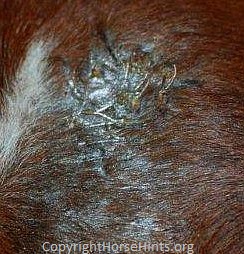 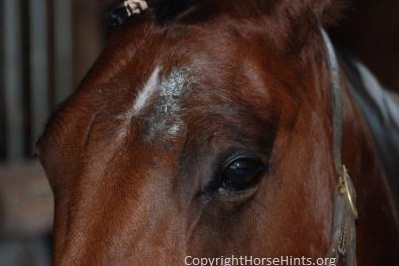 Day 15/Monday, August 30, 2010 -Today Dr. Sabo and Sarah arrived at 10:00 AM to remove A Patchy's stitches. They checked out the wound and said it had healed well. The stitches were removed. We asked if the depressions would fill in over time and the answer was yes. Dr. Sabo stated that the granulated tissue would most like fill in underneath the hide and make a small cushion between the hide and the bone. This entire episode has been a learning experience, but I hope that it never happens again! It is my wish that if this happens to one of your horses this article may be beneficial to you.  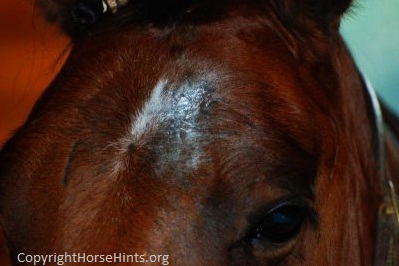 We turned A Patchy out with a flymask on. It is going to be really hot for the next few days--in the 90s. This weekend is suppose to be in the upper 70s so we will be riding. Saturday/Sept. 4, 2010 and Sunday/Sept. 5, 2010 - Looks really good. Can see some granulated tissue areas starting to fill in. Look at the red marks--those are the areas. To the touch I can also feel some flesh starting to fill in over the bone. 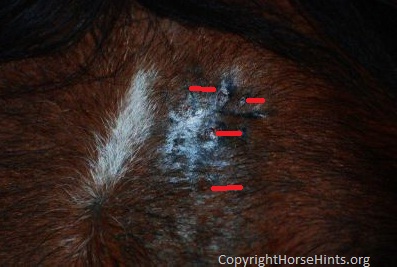  Sat., Sept 4, 2010 and Sun., Sept. 5, 2010, respectively When to Call Vet Immediately/Use Good Judgment! If in Doubt-Call
For More Information: Treating Head Injuries in Horses (An excellent article) |